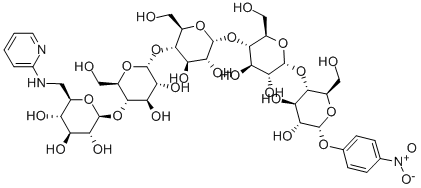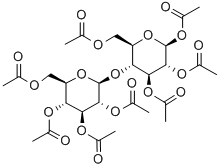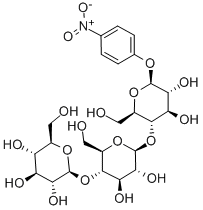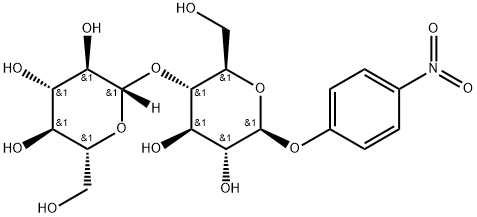XYLOBIOSE
Synonym(s):(2R,3R,4R)-2,3,5-Trihydroxy-4-[(2S,3R,4S,5R)-3,4,5-trihydroxyoxan-2-yl]oxypentanal;4-O-β-D -Xylopyranosyl-D -xylose;Xylobiose
- CAS NO.:6860-47-5
- Empirical Formula: C10H18O9
- Molecular Weight: 282.24
- MDL number: MFCD00135984
- SAFETY DATA SHEET (SDS)
- Update Date: 2024-11-19 23:02:33

What is XYLOBIOSE?
The Uses of XYLOBIOSE
Xylobiose is a disaccharide that can reduce the blood sugar and blood fat and inhibit the fat accumulation of diet-induced obese rats.
What are the applications of Application
1,4-D-Xylobiose is a polysaccharide
Definition
ChEBI: Xylobiose is a glycosylxylose that is D-xylopyranose having a beta-D-xylopyranosyl residue attached at position 4 via a glycosidic bond. It has a role as a bacterial metabolite.
Properties of XYLOBIOSE
| Melting point: | 186-187 °C |
| Boiling point: | 604.0±55.0 °C(Predicted) |
| Density | 1.61±0.1 g/cm3(Predicted) |
| storage temp. | 2-8°C |
| solubility | Water (Slightly) |
| pka | 12.40±0.20(Predicted) |
| form | powder |
| color | White to Off-White |
| Stability: | Stable under recommended storage conditions., Stable Under Recommended Storage C |
| CAS DataBase Reference | 6860-47-5 |
Safety information for XYLOBIOSE
Computed Descriptors for XYLOBIOSE
| InChIKey | LGQKSQQRKHFMLI-WSNPFVOISA-N |
New Products
4-AMINO-TETRAHYDRO-PYRAN-4-CARBOXYLIC ACID HCL 4-(Dimethylamino)tetrahydro-2H-pyran-4-carbonitrile 4-Aminotetrahydropyran-4-carbonitrile Hydrochloride (R)-3-Aminobutanenitrile Hydrochloride 3-((Dimethylamino)methyl)-5-methylhexan-2-one oxalate 1,4-Dioxa-8-azaspiro[4.5]decane 5-Bromo-2-nitropyridine Nimesulide BP Aceclofenac IP/BP/EP Diclofenac Sodium IP/BP/EP/USP Mefenamic Acid IP/BP/EP/USP Ornidazole IP Diclofenac Potassium THOMAIND PAPER PH 2.0 TO 4.5 1 BOX BUFFER CAPSULE PH 9.2 - 10 CAP SODIUM CHLORIDE 0.1N CVS ALLOXAN MONOHYDRATE 98% PLATINUM 0.5% ON 3 MM ALUMINA PELLETS (TYPE 73) LITHIUM AAS SOLUTION 2-Bromo-1-(bromomethyl)-3-chloro-5-nitrobenzene 2-Bromo-3-nitroaniline N-(3-Hydroxypropyl)-N-methylacetamide 3-Bromo-6-chloropyridazine 4-ethyl-3-nitrobenzoic acidRelated products of tetrahydrofuran








You may like
-
 Xylobiose CAS 6860-47-5View Details
Xylobiose CAS 6860-47-5View Details
6860-47-5 -
 Xylobiose CAS 6860-47-5View Details
Xylobiose CAS 6860-47-5View Details
6860-47-5 -
 1823368-42-8 98%View Details
1823368-42-8 98%View Details
1823368-42-8 -
 2-(3-(tert-butyl)phenoxy)-2-methylpropanoic acid 1307449-08-6 98%View Details
2-(3-(tert-butyl)phenoxy)-2-methylpropanoic acid 1307449-08-6 98%View Details
1307449-08-6 -
 Ethyl 3-(furan-2-yl)-3-hydroxypropanoate 25408-95-1 98%View Details
Ethyl 3-(furan-2-yl)-3-hydroxypropanoate 25408-95-1 98%View Details
25408-95-1 -
 2-Chloro-5-fluoro-1-methoxy-3-methylbenzene 98%View Details
2-Chloro-5-fluoro-1-methoxy-3-methylbenzene 98%View Details
1805639-70-6 -
 1784294-80-9 98%View Details
1784294-80-9 98%View Details
1784294-80-9 -
 Lithium ClavulanateView Details
Lithium ClavulanateView Details
61177-44-4
Statement: All products displayed on this website are only used for non medical purposes such as industrial applications or scientific research, and cannot be used for clinical diagnosis or treatment of humans or animals. They are not medicinal or edible.